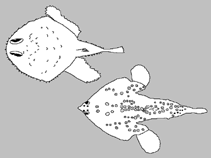Halieutopsis murrayi Ho, 2021
Murray's deepsea batfish
Upload your photos and videos
Google imageNo image available for this species;
drawing shows typical species in Ogcocephalidae.
Google imageNo image available for this species;
drawing shows typical species in Ogcocephalidae.
Classification / Names Common names | Synonyms | Catalog of Fishes(genus, species) | ITIS | CoL | WoRMS | Cloffa
Teleostei (teleosts) > Lophiiformes (Anglerfishes) > Ogcocephalidae (Batfishes)
Etymology: Halieutopsis: Greek, halieutis = fisher + Greek, opsis = apperance (Ref. 45335); murrayi: Named after Sir John Murray (1841–1914).
Etymology: Halieutopsis: Greek, halieutis = fisher + Greek, opsis = apperance (Ref. 45335); murrayi: Named after Sir John Murray (1841–1914).
Environment: milieu / climate zone / depth range / distribution range Ecology
Marine; bathydemersal; depth range ? - 1270 m (Ref. 127411). Deep-water
Distribution Countries | FAO areas | Ecosystems | Occurrences | Point map | Introductions | Faunafri
East Indian Ocean: Yemen.
Size / Weight / Age
Short description Identification keys | Morphology | Morphometrics
This species is distinguished by the following characters: body uniformly black; principal tubercles on rostrum are trifid; subopercular tubercle elongated and divided into four spinelets distally; tubercles on dorsal and ventral surfaces and tail are all simple, rather apart from each other with naked skin in between; tubercles on disk margin somewhat depressed, bifurcate at the tip; tubercles on dorsal surface with 5-8 facets; dorsal lobe of esca with two pairs of cirri; head narrow, 26.9% SL; interorbital space also narrow, 8.2% SL; illicial cavity narrow, 7.0% SL; all fins are relatively long (dorsal-fin length 19.1% SL, pectoral-fin length 31.6% SL, anal-fin length 19.7% SL, caudal-fin length 31.0% SL) (Ref. 127411).
Life cycle and mating behavior Maturity | Reproduction | Spawning | Eggs | Fecundity | Larvae
Main reference
Upload your references | References | Coordinator : Ho, Hsuan-Ching | Collaborators
Ho, H.-C., 2021. Taxonomy and distribution of the deep-sea batfish genus Halieutopsis (Teleostei: Ogcocephalidae), with descriptions of five new species. J. Mar. Sci. Eng. 10(1):34. (Ref. 127411)
CITES
Not Evaluated
Threat to humans
Harmless
Human uses
Fisheries: of no interest
FAO - Publication: search | FishSource |
More information
Trophic ecology
Food items
Diet composition
Food consumption
Food rations
Predators
Food items
Diet composition
Food consumption
Food rations
Predators
Ecology
Ecology
Ecology
Population dynamics
Growth parameters
Max. ages / sizes
Length-weight rel.
Length-length rel.
Length-frequencies
Mass conversion
Recruitment
Abundance
Growth parameters
Max. ages / sizes
Length-weight rel.
Length-length rel.
Length-frequencies
Mass conversion
Recruitment
Abundance
Life cycle
Reproduction
Maturity
Maturity/Gills rel.
Fecundity
Spawning
Spawning aggregations
Eggs
Egg development
Larvae
Larval dynamics
Reproduction
Maturity
Maturity/Gills rel.
Fecundity
Spawning
Spawning aggregations
Eggs
Egg development
Larvae
Larval dynamics
Anatomy
Gill area
Brain
Otolith
Gill area
Brain
Otolith
Physiology
Body composition
Nutrients
Oxygen consumption
Swimming type
Swimming speed
Visual pigments
Fish sound
Diseases & Parasites
Toxicity (LC50s)
Body composition
Nutrients
Oxygen consumption
Swimming type
Swimming speed
Visual pigments
Fish sound
Diseases & Parasites
Toxicity (LC50s)
Genetics
Genetics
Heterozygosity
Heritability
Genetics
Heterozygosity
Heritability
Human related
Aquaculture systems
Aquaculture profiles
Strains
Ciguatera cases
Stamps, coins, misc.
Aquaculture systems
Aquaculture profiles
Strains
Ciguatera cases
Stamps, coins, misc.
Tools
E-book | Field guide | Length-frequency wizard | Life-history tool | Point map | Classification Tree
| Catch-MSY |
Special reports
Download XML
Internet sources
AFORO (otoliths) | Aquatic Commons | BHL | Cloffa | BOLDSystems | Websites from users | Check FishWatcher | CISTI | Catalog of Fishes: genus, species | DiscoverLife | ECOTOX | FAO - Publication: search | Faunafri | Fishipedia | Fishtrace | GenBank: genome, nucleotide | GloBI | Google Books | Google Scholar | Google | IGFA World Record | MitoFish | Otolith Atlas of Taiwan Fishes | PubMed | Reef Life Survey | Socotra Atlas | Tree of Life | Wikipedia: Go, Search | World Records Freshwater Fishing | Zoobank | Zoological Record
Estimates based on models
Phylogenetic diversity index (Ref. 82804): PD50 = No PD50 data [Uniqueness, from 0.5 = low to 2.0 = high].




